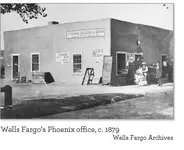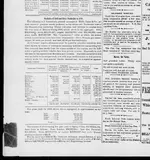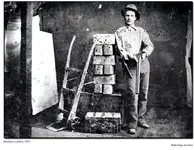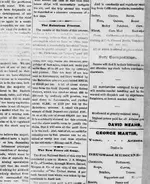Cactusjumper wrote
Roy,
Yes, I will have to stick with what Dr. Robert J. Chandler, senior research historian for Wells Fargo Bank told me personally a few years ago. Wells Fargo did not ship ORE until the railroad could take it. They did not ship out of Arizona but used other coach lines for freight. They only shipped bullion, not ore. There was never a U.S.mint in Sacramento, which is where Terry said Waltz's shipment of ORE was sent.
$250,000. worth of ore was one hell of a lot of rocks. That alone was the first thing that made me suspicious. Many top LDM Researchers tried to find some truth in that story. They all came up with NADA. I think I may have been the first one to speak, personally, to the top Wells Fargo Historian in San Francisco.
You have defended your position very well, but I remain skeptical. What was the year of that receipt?
I never said that there was never any gold shipped from Arizona, by wells Fargo, prior to Waltz's death. Larkin was guarding silver bullion from the Tip Top Mine in that picture.
I think we can agree to disagree about that huge shipment of ore by Waltz.
Take care and get back to work.
Taking the last first, (you slave driver you!

) I can certainly agree to disagree about the "huge shipment" of ore. More on this in a moment, but the next item is one you appear to be mistaken about for here is your earlier post:
Roy,
One thing for clarification. Wells Fargo did not have any receipts for that era, because they did not ship any gold ore out of Arizona, not because they were lost in the San Francisco earthquake/fire.
Take care,
Joe
I read that as your stating that Wells Fargo did not ship ANY gold ore out of Arizona, when there are published records from Wells Fargo in the old newspapers that list several million dollars worth of ORE shipped from Arizona, and prior to Waltz's death.
Higham's letter and I believe Terry's book both say they are
RECEIPTS plural, not ONE single shipment. The ore assayed at $110,000 per ton, so works out to something like two and a half tons. That is NOT a hell of a lot of rock, and very easily could have been sent in several shipments rather than ONE large one. I am not sure exactly but it works out to something like two cubic yards of ore or a bit less; somewhere between 18 and 28 wheelbarrow loads, or around forty burro loads or twenty mule or horse loads. Over the span of
years, in several shipments (as in maybe fifty pounds at a time) this is not too remarkable IMHO.
I did not state that Waltz shipped his ore to Sacramento, and neither does Higham; in fact i
t does not say WHERE the ore was shipped to. Terry has other errors in his book too - does that make the whole to be worthless? There were smelters operating in Sacramento for that matter whom a gold miner could ship ore to in that time period. Didn't we go over this just a few years ago?
I realize that I am not among the "to
p LDM Researchers " and don't care, but
even the experts can be wrong. I can prove that too. This includes Dr Chandler. I communicated with him too, if you recall, and
he is the one that informed me t
hat Wells Fargo simply has NO records, due to loss in a fire. That they have NO records does not prove what they did or did
not ship. The old Arizona newspapers are actually a more reliable source on Wells Fargo in Arizona during this time period than Wells Fargo itself is today due to the loss of those records.
Wells Fargo acted through agents in Arizona and elsewhere, but
the receipts would still be Wells Fargo and they would get a cut from the freight business. Wells Fargo would be the party responsible in case of loss, and Wells Fargo certainly was taking credit for handling shipments of gold from the territory as is even in the Congressional Record. The point is that
the Wells Fargo Express shipping receipts story is absolutely possible. You may continue to believe what ever and whomever you prefer, as I have seen through repeated experience, if some expert you recognize tells you something, like father Polzer or Dr Glover or Dr Chandler, that holds
far more weight with you than
anything that I might provide that is counter to it.
Now to continue on topic, we can establish that
there were several different Jacob Waltz (s) in the US during the time period when "our" Waltz was alive, including the one in Kansas whom was from Wurttemburg. Wurttemburg at that time had its own king and was a separate country, and Waltz (ours) listed Prussia as his native land on one document which is different enough to raise questions.
Another point, concerning the story of Waltz having been a Confederate soldier, but he was also reported as being a staunch Republican voter. Two things can be extrapolated from this point, first, you can not vote without being a citizen so this re-affirms that he must have won citizenship, and second, no self respecting Reb would EVER consider voting Republican after the Civil War. Not saying it would be impossible for an ex-Confederate to later vote Republican, but it would be pretty uncommon. This points to Waltz being a Union man even in his politics.
Waltz also filed a homestead claim in Phoenix, and you could not make such a claim unless you were a citizen, so this too supports that he had US citizenship by 1868.
More to follow,
Oroblanco














 ) I can certainly agree to disagree about the "huge shipment" of ore. More on this in a moment, but the next item is one you appear to be mistaken about for here is your earlier post:
) I can certainly agree to disagree about the "huge shipment" of ore. More on this in a moment, but the next item is one you appear to be mistaken about for here is your earlier post:

